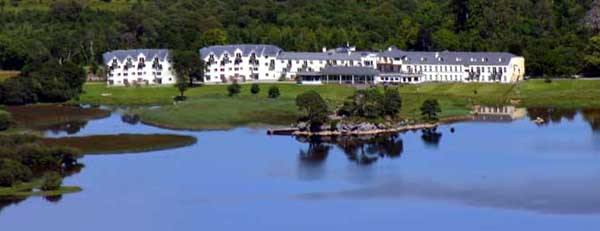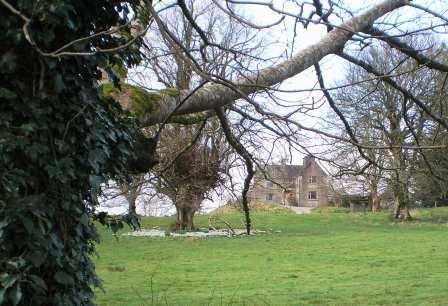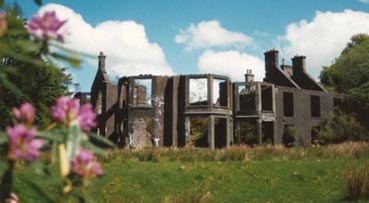Bridgeville Park
Houses within 15km of this house
Displaying 32 houses.
Houses within 15km of Bridgeville Park
Displaying 32 houses.
| House name | Description | |
|---|---|---|
| Killaha Castle or Killaha House | The original property at Killaha was Killaha Castle, the hereditary seat of the O’Donoghue of the Glens. The family had moved to Killarney by the 19th century. Lewis records that Killaha House was then the seat of J. McCarthy. At the time of Griffith’s Valuation, John McCarthy was leasing the house to Frederick Millbourne, MD, when it was valued at £16 10s. Bary indicates that it was subsequently rented by the Orpen family and later, possibly in the 1890s, given to the Catholic church by R.M. Leeson Marshall who was descended from the O’Donoghues of Killaha. It afterwards served as the presbytery for the local parish. | |
| Muckross House (Muckross Abbey) | McCoole states that the Herberts had a house on the Muckross peninsula since at least the early 18th century, on lands leased from the MacCarthaigh Mor family. A new house was constructed in the 1770s. In 1837 Lewis described Muckross as "situated in a demesne of enchanting beauty". The present Muckross House, was built between 1839-43. At the time of Griffith’s valuation it was valued at £129. It continued to be owned by the Herbert family until the 1890s, when, the family fortunes having declined, it was sold by the Standard Life Assurance Company, and purchased by Lord Ardilaun. He was the owner in 1906 when it was valued at £130. In 1910 it was sold to an American family, Bowers Bourn who in turn gave it to their daughter and son-in-law, Maud and Arthur Vincent. It was presented to the nation in 1932 and now forms the centre of the Killarney National Park. |

|
| Lord Brandon's Cottage | At the time of Griffith’s Valuation, Robert Chambers was leasing a property valued at almost £9 from Henry Herbert. Lewis mentions a house at this location as the seat of Rev. J. Hutchinson in 1837. This is now the site of a refreshment centre for tourists visiting the Gap of Dunloe. |

|
| Looscaunagh | Henry Herbert was leasing a property valued at almost £4, along with over 400 acres, to Daniel McCarthy at the time of Griffith’s Valuation. It is no longer extant. | |
| Muckross Hotel | William Roche was leasing a property valued at £30 from the Herbert estate at the time of Griffith’s Valuation. The building marked as hotel on the 1st edition 6” map is recorded on the 1894 map as Muckross Hotel. Roche was leasing an adjoining building, valued at £13, from Daniel Clifford in the same vicinity. Horgan states that the Tourist’s Illustrated Handbook for Ireland, 1853, refers to Mr. Roche as manager of the Muckross Hotel. The property is still a hotel, now known as the Muckross Park Hotel. Daniel O’Sullivan was leasing a property in the same area from the Herbert estate, valued at £12 12s. In 1906 Lord Ardilaun owned the property at Dromyrourk valued at £20. |

|
| Torc Cottage | At the time of Griffith’s Valuation, Henry Herbert was leasing a property at Torc, valued at £39, to Sir Thomas Herbert. Lewis refers to it as the residence of Capt. Herbert in 1837 while Leet mentions it as the seat of Charles Herbert in 1814. In 1906 it was part of the Guinness estate and valued at £11 10s. Bary states that Torc Cottage was a handsome property surrounded by plantations. McCoole claims that Henry Arthur Herbert had built Torc Cottage for his mistress. The building is no longer extant. | |
| Castle Lough | Martin Lawlor was leasing a property valued at £55 to Thomas Cotter at the time of Griffith’s Valuation. It is described by Lewis as the seat of D.S. Lawlor in 1837. Bary states that there was an earlier house, belonging to the Madden family, at this site. In the later 19th century, Thomas Cotter ran the property as an hotel. It has been incorporated into the Lake Hotel complex. See www.lakehotel.com. |

|
| Ardagh | Martin Lawlor was in possession of a property valued at £11 5s at Ardagh, at the time of Griffith’s Valuation. There is no house marked on the 1st edition OS map, the Lakeview Hotel appears to have occupied the site in 1895. | |
| Torc View (Torc View Hotel) | Jeremiah Hurley was leasing a hotel valued at £40 from the Gallway estate at the time of Griffith’s Valuation. This was the Torc View Hotel. Horgan states that the building was later purchased by the Loretto Sisters and opened as a boarding school. It is labelled Loretto Convent on the 25-inch map of the 1890s. The site is now occupied by town houses. | |
| Glena Cottage | At the time of Griffith’s Valuation, the Kenmare estate held properties described as cottages, valued at £16. Horgan indicates that these cottages were built on the estate to cater for tourist visitors. Lewis, in 1837, mentions the elegant cottage of Lady Kenmare, at a short distance from which a banqueting house had been erected by Lord Kenmare for the entertainment of visitors. In 1906 the property at Glena was valued at £16 15s. Bary states that Glena Cottage was burnt in 1922. |

|
| Sheheree Cottage | Captain Denis Curtayne was leasing a property from Lord Kenmare’s estate at the time of Griffith’s Valuation, when it was valued at £17 5s. In 1885 Walford mentions Edward Morrogh Bernard "of Sheheree". Bary also states that the property was later associated with the Morrogh Bernard family. In 1994 it was still extant and occupied. | |
| Brewsterfield House | Daniel Reardon was leasing Brewsterfield House from the representatives of Rev. B. Herbert at the time of Griffith’s Valuation, when it was valued at £13 10s. Lewis notes it as the seat of Rev. B. Herbert in 1837. Bary suggests that it was built by Sir Francis Brewster in the early 18th century but may have been added to later by the Herberts. It later passed to the Orpen family through marriage and may have been resided in by their agent. The original house was demolished in 1985. There are modern buildings on the site including holiday cottages. | |
| Parkgariffe | The representatives of Reverend D. Mahony were leasing a house valued at £9 to Barbara Strange at the time of Griffith’s Valuation. This property was included in the sale of the Freeman estate in 1850, when it was occupied by Mrs. Elizabeth Strange, under a lease dating from 1828. Bary states that it was later lived in by the Spottiswood Green family. There is still an occupied house at the site but it may have been altered. | |
| Dunkerron House | Lewis records that Dr. Taylor was occupying a property adjacent to the ruined castle at Dunkerron in 1837. In 1814, Leet refers to Dunkerrin Castle as the seat of George Cashell. At the time of Griffith’s Valuation, Joseph Taylor was leasing a property there valued at £16 15s from Deane Freeman. Bary states that Joseph Taylor was an agent for the Landsdowne estate. The Taylor property then passed to Dr. Thomas Taylor who built Dunkerron House. In 1906 this was the property of Sir John C. Columb and valued at £22. The property is still extant but extensive housing development has taken place in the demesne. | |
| Tubbrid House | At the time of Griffith's Valuation, John M. Hickson was occupying Tubbrid House, parish of Templenoe, valued at £9. Bary states that the house was built by the [O]'Mahony-Hickson family. There is still an occupied house at the site though it may have been altered. . | |
| Dromneavane | Rev. John O'Sullivan was leasing a property valued at £8 5s from the Lansdowne estate at the time of Griffith's Valuation. Labelled Dromneavane on both the 1st-edition and 25-inch Ordnance Survey Maps. A house still exists at the site. | |
| Lansdowne Lodge | William S. Trench, Lord Lansdowne's agent, was occupying this property at the time of Griffith's Valuation, when it was valued at £27. In 1837 Lewis refers to it as the residence of the then agent, J. Hickson. Bary states that it was the home of the various agents of the Lansdowne estate throughout the nineteenth and early twentieth centuries. It was demolished in the latter decades of the twentieth century and a housing estate built on the grounds. | |
| Reenmore House | Rev. John Day was leasing a property valued at £12 15s from the Lansdowne estate at the time of Griffith's Valuation. This may have been the conjoined property labelled Sound House and Fir View on the 1st edition Ordnance Survey Map. On the 25-inch map of the 1890s, Sound House has become known as Reenmore House. The are still extant buildings at the site. | |
| Sheen Cottage/The Falls | George Woodhouse was leasing a property valued at £6 from the Lansdowne estate at the time of Griffith's Valuation. On the 1st edition OS map the house in this townland is named Sheen Cottage. On the 25-inch map of the 1890s it is labelled The Falls. It is now the Sheen Falls Lodge hotel. See www.sheenfallslodge.ie. |

|
| Riversdale (Kenmare) | George Mayberry, MD, was leasing Riversdale from the Lansdowne estate at the time of Griffith's Valuation, when it was valued at £12 5s. Bary states that the house was in the Mayberry family until the early twentieth century when it was pruchased by the Representative Church Body who owned it until the 1960s. It is now an hotel. |

|
| The Cottage (Kenmare) | At the time of Griffith's Valuation, Francis Downing was a leasing a property at Mucksna, Kenmare, to Agnes Godfrey, when it was valued at £9. This may be the property which Bary refers to as Tom Moore's cottage, still extant and occupied. | |
| Roughty Lodge | According to Bary, Roughty Lodge was owned by Capt. Massey Herbert in the 1820s. At the time of Griffith's Valuation, it was being leased by Mrs. Elizabeth Herbert, nee Orpen from John Dunscum and was valued at £9. It is still extant and in 2009 was offered for sale. |

|
| Shelburne Lodge | In 1786 Wilson refers to "the Earl of Shelburne's lodge at Kenmare". William Lawrenson was leasing Shelbourne Lodge at the time of Griffith's Valuation when it was valued at £10. The lessor is named as Garrett Riordan though Bary states that the house was part of the Lansdowne estate and may, in the eighteenth century, have been used by the estate agent. It has had several owners since its sale in the early twentieth century but is still extant and now run as a guesthouse. See www.shelburnelodge.com |

|
| Ardtully House | Richard J.T. Orpen was leasing Ardtully House from John Croker at the time of Griffith's Valuation, when it was valued at £23 5s. In 1814 Leet records it as the seat of Richard O. Townsend while Lewis, in 1837 mentions Ardtully as "the ancient mansion of Richard Orpen Townsend". It was also the seat of the Orpen family in the 1770s and 1780s. Bary states that this property included an earlier castle, which was originally part of the McFineen McCarthy lands forfeited in the seventeenth century. It was granted by the Hollow Blade Company to the Conways but, later in the eighteenth century, the Orpens were occupying the house, subsequently replaced in the nineteenth century. Recorded, perhaps mistakenly, as the seat of R.H.M. Orpen and Sir. R.J.T Orpenm in 1894, in 1906 it was owned by Richard H.M. Orpen and valued at £40. The Scottish-baronial style house was burnt in 1921 but the ruins remain. |

|
| Cloontoo | Adrian Taylor was leasing a property valued at £15 15s from John Croker at the time of Griffith's Valuation. Lewis notes it as the seat of R.E. Orpen in 1837. In 1814 Leet records the house as the seat of Edward Orpen. In 1851 the property was included in the sale of the Croker estate in the Encumbered Estates Court when Adrian Taylor was the occupier. It remained a residence of the Taylor family until the 1950s. Cloontoo is still extant and occupied. | |
| Woodville | Richard Orpen was occupying a property valued at £18 5s at the time of Griffith's Valuation. Lewis also notes it as his residence in 1837. In 1814 Leet recorded it as the seat of Samuel Orpen. Bary states that this house was sometimes known as Cranberry House, though on the Ordnance Survey maps it appears as Woodville. It was occupied by various members of the Orpen family throughout the nineteenth century but is now ruinous. | |
| Sillahertane House | John B. Warren was leasing this property from Richard Orpen at the time of Griffith's Valuation, when it was valued at £8 10s. It is named on the 1st edition Ordnance Survey map as Sillahertane Cottage though Lewis records it as Sillerdine Cottage in 1837. Bary indicates that it was also known as Sillahertane House and Warren's Lodge.The house later came into the possession of Francis Wise Low, of Kilshane, county Tipperary, who extended it in the early years of the twentieth century. In 1906 it was owned by Sarah S. Lowe and valued at £40. It was burnt in 1921 and is now a ruin. It forms part of a 500-acre sporting estate which also includes a self-catering holiday home, dating from the 1870s. See www.sillahertane.com.for an in-depth history of the estate. |

|
| Kilfadda More | At the time of Griffith's Valuation, Daniel McCarthy was leasing this property to Patrick Kelleher, when it was valued at £2 10a. Lewis records it as the seat of D.McCarthy in 1837 and Leet noted it as the address of Timothy McCarthy in 1814. The Irish Tourist Association survey in 1943 recorded the story that the patriots Michael Doheny and James Stephens were hidden here while "on the run" in 1848, when Kilfadda More was "a thatched cottage occupied by Dick McCarthy". Bary states that it was associated with the McCarthy family for many years. It is still extant and occupied. |

|
| Greenlane | At the time of Griffith's Valuation, George Mayberry owned this property, valued at £9. Lewis refers to is as the seat of Mrs.Mayberry in 1837 and Leet as the residence of John Maybury in 1814. In 1906 it was owned by Francis Mayberry and valued at £5. Bary states that it was in the possession of the Maybury family from the eighteenth century until the 1940s. Prior to that it was associated with the Duckett family. It was demolished in the later twentieth century. | |
| Killowen House | At the time of Griffith's Valuation, Edward Orpen was leasing this property from the Landsdowne estate when it was valued at £3. Lewis mentions it as the occasional residence of H. Orpen in 1837. In the 1770s it was noted by Taylor and Skinner but no proprietor is given. Bary notes that this property was originally in the possession of the Taylor estate but was was taken over by the Orpens in the early eighteenth century. It passed through marriage to the Palmer family. It was demolished in the twentieth century | |
| Marino Lodge | In 1906 John Columb owned this property, then valued at £6 10s. There are two bathing lodges in this area at the time of Griffith's Valuation, Marino Lodge and Clashganniv. These properties seem to have been part of the Langford estate. | |
| The Shrubberies (Kenmare) | At the time of Griffith's Valuation, Kenmare Board of Poor Law Guardians were leasing this property from Nathaniel Irvine as an Auxiliary workhouse, when it was valued at £37. On the 1st edition Ordnance Survey map it is labelled Monastery but on the later 25-inch Map of the 1890s it appears as The Shrubberies. It is still extant. |

